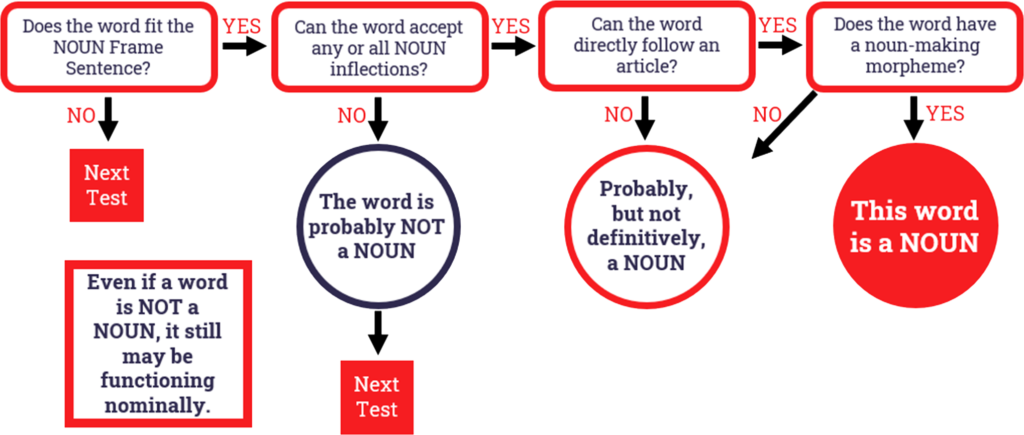Chapter 1: Nouns
A NOUN is a form-class word that typically names something: entities, concrete things, or abstract things.
A prototypical noun will have five characteristics:
- Has a noun-making (derivational) morpheme
- Can occur with the plural inflectional morpheme [-s]
- Can occur with the possessive inflectional morpheme [-‘s]
- Can directly follow an article (or other determiner)
- Fits the frame sentence: (The) <BLANK> seems all right.
These five characteristics serve as the primary tests for identifying nouns.
In general, a prototypical noun will have 4-5 of these characteristics. The more noun characteristics a word has, the more prototypical it is. The fewer noun characteristics a word has, the more it becomes a peripheral case.
A word like government has all five characteristics:
- Has a noun-making (derivational) morpheme: government
- Can occur with the plural inflectional morpheme: governments
- Can occur with the possessive inflectional morpheme: government’s
- Can directly follow an article (or other determiner): the government
- Fits the frame sentence: The government seems all right.
Peripheral cases include:
- nouns derived from adjectives (happiness, diligence)
- nouns derived from verbs (reaction, runner)
- adjectives that are also nouns (red, cold)
- verbs that are also nouns (run, hit)
For example, a noun like happiness only fulfills two of the five noun characteristics:
- Has a noun-making (derivational) morpheme: happiness
- Does not usually occur with the plural inflectional morpheme: *happinesses
- Does not usually occur with the possessive inflectional morpheme: *happiness’s
- Does not directly follow an article (or other determiner) when it stands alone without modifiers: *a/the happiness
- Fits the frame sentence: Happiness seems all right.
The morpheme –ness makes nouns from adjectives, as in friendliness and creaminess.
With modifiers, the article becomes more common: the happiness of the people
Happiness is not a good example of a prototypical noun because it only has two noun characteristics. This does not mean that if can’t be identified as a noun, or that it can’t function nominally, but it does make it a peripheral case.
Members of all four form classes can be divided into further subclasses based on certain semantic features. These features often have grammatical consequences. Subclasses of nouns are often presented in pairs and include:
- Proper Nouns and Common Nouns
- Count Nouns and Noncount (Mass) Nouns
- Human Nouns and Nonhuman Nouns
- Animate Nouns and Inanimate Nouns
- Male Nouns and Female Nouns
We do not find them necessary for identifying nouns in context, so we will not go into detail on these subclasses in this chapter.
When analyzing for nouns, we identify the FORM of the analyzed word as noun. You can use the following flowchart to guide your analysis:


